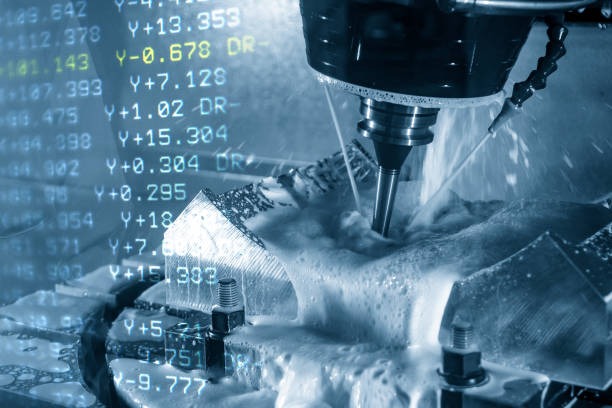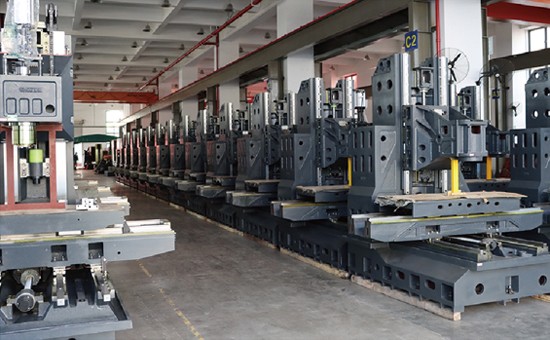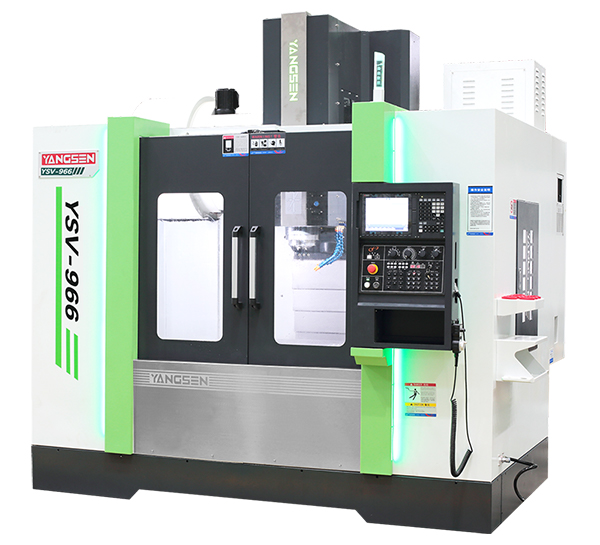सीएनसी स्वचालन, पारंपरिक सीएनसी मशीनिंग प्रक्रियाओं को बेहतर बनाने, दक्षता में सुधार, त्रुटियों को कम करने और उत्पादकता बढ़ाने के लिए स्वचालित प्रणालियों के उपयोग को संदर्भित करता है। रोबोटिक्स, एआई, आईओटी और उन्नत सेंसरों का यह एकीकरण सीएनसी मशीनों को न्यूनतम मानवीय हस्तक्षेप के साथ संचालित करने की अनुमति देता है, जिससे वे अधिक स्मार्ट और विश्वसनीय बन जाती हैं।
रोबोटिक्स एकीकरण:
रोबोट लोडिंग/अनलोडिंग को स्वचालित करते हैं, डाउनटाइम कम करते हैं और उत्पादन की गति बढ़ाते हैं। वे बिना किसी रुकावट के काम करते हैं सीएनसी मशीनिंग केंद्र प्रक्रियाओं को सुव्यवस्थित करने के लिए।
एआई और मशीन लर्निंग:
एआई प्रणालियाँ उपकरण के घिसाव का पूर्वानुमान लगाती हैं और वास्तविक समय में मशीनिंग मापदंडों को समायोजित करती हैं, जिससे सटीकता में सुधार होता है और डाउनटाइम कम होता है। एआई-संचालित सीएनसी मशीनें बेहतर प्रदर्शन के लिए बदलती परिस्थितियों के अनुकूल ढल जाती हैं।
IoT एकीकरण:
IoT दूरस्थ निगरानी के लिए CNC मशीनों को जोड़ता है, जिससे ऑपरेटरों को प्रदर्शन पर नज़र रखने और बेहतर निर्णय लेने के लिए वास्तविक समय में डेटा एकत्र करने में मदद मिलती है।
सेंसर और स्वचालन सॉफ्टवेयर:
सेंसर वास्तविक समय के आंकड़ों के आधार पर मशीन सेटिंग्स को स्वचालित रूप से समायोजित करते हैं, जिससे पूरे उत्पादन में इष्टतम प्रदर्शन और परिशुद्धता सुनिश्चित होती है।

सीएनसी स्वचालन से उत्पादकता बढ़ती है, लागत कम होती है और परिशुद्धता में सुधार होता है। न्यूनतम मानवीय हस्तक्षेप के साथ, स्वचालित सीएनसी प्रणालियाँ निरंतर काम कर सकती हैं, जिससे निरंतर गुणवत्ता और तेज़ उत्पादन चक्र सुनिश्चित होता है।
जैसे-जैसे विनिर्माण क्षेत्र स्मार्ट और अधिक कनेक्टेड उत्पादन की ओर बढ़ रहा है, सीएनसी स्वचालन तेज़ी से विकसित हो रहा है। 2025 में उद्योग को आकार देने वाले प्रमुख रुझान निम्नलिखित हैं।
सीएनसी मशीनिंग केंद्रों में टूल पथों को अनुकूलित करने, सेटअप समय को कम करने और ऑपरेटर की त्रुटियों को न्यूनतम करने के लिए कृत्रिम बुद्धिमत्ता का उपयोग तेज़ी से बढ़ रहा है। एआई प्रणालियाँ मशीनिंग डेटा का विश्लेषण करके टूल के घिसाव का पूर्वानुमान भी लगाती हैं, जिससे निरंतर सटीकता सुनिश्चित होती है।
रोबोटिक भुजाओं और सहयोगी रोबोटों (कोबोट्स) का उपयोग लगातार बढ़ रहा है। रोबोट पुर्जों को लोड/अनलोड कर सकते हैं, दोहराए जाने वाले कार्यों को संभाल सकते हैं, और मनुष्यों के साथ सुरक्षित रूप से काम कर सकते हैं। यह उच्च-मिश्रण, कम-मात्रा वाले वातावरण में सीएनसी टर्निंग और मिलिंग मशीनों के लिए विशेष रूप से उपयोगी है।
IIoT के साथ, सीएनसी मशीनें अब केंद्रीकृत निगरानी प्रणालियों से जुड़ी हुई हैं। ऑपरेटर वास्तविक समय में प्रदर्शन, ऊर्जा उपयोग और मशीन की स्थिति पर नज़र रख सकते हैं। इससे पूर्वानुमानित रखरखाव संभव होता है, अप्रत्याशित डाउनटाइम कम होता है और मशीन का उपयोग बढ़ता है।
डिजिटल ट्विन तकनीक निर्माताओं को उत्पादन से पहले मशीनिंग प्रक्रिया की एक आभासी प्रतिकृति बनाने में सक्षम बनाती है। इंजीनियर काटने की रणनीतियों का परीक्षण कर सकते हैं, औज़ारों की गति का अनुकरण कर सकते हैं, और सामग्री की बर्बादी किए बिना इंडेक्सेबल मिलिंग टूल्स या टर्निंग इंसर्ट को अनुकूलित कर सकते हैं।
2025 में स्थिरता एक प्राथमिकता है। नई सीएनसी मशीनें ऊर्जा लागत कम करने के लिए उच्च-दक्षता वाली मोटरें, पुनर्योजी ब्रेकिंग और बेहतर शीतलन प्रणालियाँ अपनाती हैं। हरित स्वचालन में निवेश करने वाले निर्माता न केवल लागत बचाते हैं, बल्कि कड़े पर्यावरणीय नियमों का भी पालन करते हैं।
सेंसरों से एकीकृत उन्नत टूलिंग मशीनों को संचालन के दौरान कटिंग मापदंडों को स्वचालित रूप से समायोजित करने की अनुमति देती है। उदाहरण के लिए, अंतर्निहित निगरानी वाली इंडेक्सेबल ड्रिल या प्रिसिज़न एंड मिल्स सतह की फिनिश को बेहतर बना सकती हैं और टूल की लाइफ बढ़ा सकती हैं।
रुझान | आवेदन | मुख्य लाभ |
एआई प्रोग्रामिंग | सीएनसी मशीनिंग केंद्र | तेज़ सेटअप, पूर्वानुमानित उपकरण प्रबंधन |
रोबोटिक्स और कोबोट्स | मिलिंग और टर्निंग लाइनें | उच्चतर थ्रूपुट, सुरक्षित संचालन |
IoT कनेक्टिविटी | फ़ैक्टरी-व्यापी CNC प्रणालियाँ | वास्तविक समय निगरानी, कम डाउनटाइम |
डिजिटल जुड़वाँ | प्रक्रिया सिमुलेशन | कम सामग्री अपव्यय, बेहतर सटीकता |
ऊर्जा दक्षता | सभी सीएनसी मशीनें | कम लागत, टिकाऊ उत्पादन |
स्मार्ट टूलिंग | काटने और ड्रिलिंग उपकरण | बेहतर परिशुद्धता, लंबा उपकरण जीवन |
सीएनसी स्वचालन आधुनिक विनिर्माण को बदल रहा है और निर्माताओं और वितरकों, दोनों के लिए महत्वपूर्ण लाभ प्रदान कर रहा है। रोबोटिक्स, एआई, आईओटी और उन्नत उपकरणों को एकीकृत करके, व्यवसाय संचालन को सुव्यवस्थित कर सकते हैं, लागत कम कर सकते हैं और उत्पाद की गुणवत्ता में सुधार कर सकते हैं।
स्वचालित सीएनसी मशीनिंग केंद्र, गैन्ट्री मशीनें, और ऊर्ध्वाधर मशीनिंग केंद्र न्यूनतम मानवीय हस्तक्षेप के साथ 24/7 संचालित हो सकते हैं।
रोबोटिक्स और स्मार्ट टूलिंग सेटअप समय को कम करते हैं और उत्पादन चक्र को तेज करते हैं।
IoT के माध्यम से वास्तविक समय की निगरानी यह सुनिश्चित करती है कि मशीनें सर्वोच्च दक्षता पर काम कर रही हैं।
स्वचालन सभी भागों में एकसमान मशीनिंग सटीकता सुनिश्चित करता है, जिससे दोष और पुनः कार्य में कमी आती है।
अनुकूली कटिंग और एआई-संचालित समायोजन के साथ स्मार्ट सीएनसी प्रणालियां उच्च गुणवत्ता वाली सहनशीलता बनाए रखती हैं।
जैसे उपकरण अनुक्रमणीय अभ्यास, टर्निंग इंसर्ट, और अंत मिलों एकसमान प्रदर्शन के लिए स्वचालित अंशांकन से लाभ।
मैनुअल ऑपरेटरों पर निर्भरता कम होने के कारण श्रम लागत कम होगी।
पूर्वानुमानित रखरखाव अप्रत्याशित डाउनटाइम और मरम्मत व्यय को न्यूनतम करता है।
ऊर्जा-कुशल सीएनसी मशीनें और टिकाऊ प्रक्रियाएं परिचालन लागत में कटौती करती हैं।
तीव्र उत्पादन चक्र से बाजार में पहुंचने का समय बढ़ जाता है, जिससे वितरकों और निर्माताओं के लिए ROI में सुधार होता है।
सीएनसी स्वचालन निर्माताओं को कम मात्रा, उच्च मिश्रण ऑर्डर और बड़े पैमाने पर उत्पादन दोनों को कुशलतापूर्वक संभालने की अनुमति देता है।
सीएनसी मशीनिंग केंद्रों की आसान पुनर्प्रोग्रामिंग नए उत्पाद डिजाइनों के लिए तेजी से अनुकूलन को सक्षम बनाती है।
स्वचालित सीएनसी समाधान प्रदान करने वाले वितरक लचीले, उच्च-प्रदर्शन उत्पादों के साथ अपने ग्राहक आधार का विस्तार कर सकते हैं।

सीएनसी स्वचालन को शीघ्र अपनाने से निर्माता और वितरक प्रतिस्पर्धियों से आगे हो जाते हैं।
कम्पनियां सटीकता, गति और विश्वसनीयता को प्रमुख विभेदक कारकों के रूप में बाजार में पेश कर सकती हैं।
स्मार्ट सीएनसी उत्पादों और स्वचालित मशीनिंग केंद्रों तक पहुंच उन्नत समाधान चाहने वाले ग्राहकों के साथ साझेदारी को मजबूत करती है।
सीएनसी स्वचालन के लाभ निर्विवाद हैं, लेकिन निर्माताओं और वितरकों को नई तकनीकों को अपनाते समय कई चुनौतियों का सामना करना पड़ सकता है। इन बाधाओं को समझने से कंपनियों को सीएनसी मशीनिंग सेंटर, वर्टिकल मशीनिंग सेंटर और टर्निंग टूल्स जैसी स्वचालित सीएनसी प्रणालियों में बदलाव करने में मदद मिल सकती है।
स्वचालित सीएनसी मशीनों और रोबोटिक्स की खरीद की प्रारंभिक लागत काफी अधिक हो सकती है, विशेष रूप से छोटे से मध्यम आकार के उद्यमों (एसएमई) के लिए।
रोबोटिक सीएनसी आर्म्स, एआई-संचालित मशीनिंग सेंटर या स्मार्ट कटिंग टूल्स जैसे उन्नत उत्पादों में निवेश करने के लिए अक्सर पर्याप्त पूंजी की आवश्यकता होती है।
हालाँकि, कम श्रम लागत, ऊर्जा दक्षता और बेहतर उत्पादकता से होने वाली दीर्घकालिक बचत, प्रारंभिक निवेश की भरपाई कर सकती है।
सीएनसी स्वचालन प्रणालियों, जैसे स्मार्ट सीएनसी मशीनें और IoT-कनेक्टेड सीएनसी प्रणालियां, के लिए ऑपरेटरों और रखरखाव कर्मचारियों के लिए विशेष प्रशिक्षण की आवश्यकता होती है।
निर्माताओं को कार्यबल विकास में निवेश करना चाहिए ताकि यह सुनिश्चित हो सके कि उनके कर्मचारी स्वचालित उपकरणों का प्रभावी ढंग से संचालन, समस्या निवारण और अनुकूलन कर सकें।
जैसे-जैसे स्वचालन विकसित होता जाएगा, नए सॉफ्टवेयर अपडेट, मशीन इंटरफेस और अत्याधुनिक प्रौद्योगिकियों के साथ तालमेल बनाए रखने के लिए निरंतर प्रशिक्षण की आवश्यकता होगी।
कई निर्माता पुरानी, पारंपरिक सी.एन.सी. मशीनों पर निर्भर रहते हैं, जो नई स्वचालित प्रणालियों के साथ संगत नहीं हो सकतीं।
मौजूदा सी.एन.सी. मशीनिंग केंद्रों में रोबोटिक भुजाओं या पूर्वानुमानित रखरखाव प्रणालियों को एकीकृत करने के लिए उत्पादन स्तर में महत्वपूर्ण संशोधनों की आवश्यकता हो सकती है।
उत्पादन में बाधा डाले बिना पुरानी और नई मशीनों के बीच निर्बाध एकीकरण सुनिश्चित करना एक आम चुनौती है।
सीएनसी प्रणालियां IoT के माध्यम से अधिक कनेक्टेड हो रही हैं, इसलिए साइबर हमलों का खतरा बढ़ गया है।
संभावित साइबर खतरों से स्वचालित प्रणालियों और संवेदनशील उत्पादन डेटा की सुरक्षा करना महत्वपूर्ण हो जाता है।
निर्माताओं को अपने परिचालन की सुरक्षा के लिए मजबूत सुरक्षा प्रोटोकॉल और एन्क्रिप्शन प्रौद्योगिकियों को लागू करने की आवश्यकता है।
नौकरी छूटने के डर या नई प्रौद्योगिकियों से अपरिचित होने के कारण कर्मचारी और प्रबंधक सीएनसी स्वचालन की ओर बदलाव का विरोध कर सकते हैं।
इस प्रतिरोध पर काबू पाने के लिए स्पष्ट संचार, कर्मचारियों की भागीदारी, तथा उत्पादकता और नौकरी की सुरक्षा दोनों के लिए स्वचालन के दीर्घकालिक लाभों का प्रदर्शन आवश्यक है।
स्वचालित सीएनसी समाधान प्रदान करके तथा यह प्रदर्शित करके कि ये उपकरण किस प्रकार मानव श्रम का पूरक बन सकते हैं, कंपनियां चिंताओं को कम कर सकती हैं।
जबकि सीएनसी स्वचालन कई मामलों में डाउनटाइम को कम करता है, एआई-संचालित सीएनसी मशीनों या रोबोटिक आर्म्स जैसी स्वचालित प्रणालियों को अभी भी नियमित रखरखाव और अंशांकन की आवश्यकता होती है।
सिस्टम विफलता की स्थिति में, स्वचालित प्रणालियों का समस्या निवारण पारंपरिक मशीनों की तुलना में अधिक जटिल हो सकता है।
स्वचालन अपनाने के दौरान डाउनटाइम को न्यूनतम करने के लिए उचित रखरखाव कार्यक्रम, बैकअप योजनाएं और कुशल तकनीशियन महत्वपूर्ण हैं।

सीएनसी स्वचालन का भविष्य विनिर्माण प्रक्रियाओं में क्रांति लाने वाला है। जैसे-जैसे तकनीक विकसित होती रहेगी, हम मशीन टूल्स, रोबोटिक्स, एआई और कनेक्टिविटी में और भी उन्नत नवाचारों की उम्मीद कर सकते हैं। अगले दशक में स्वचालन तकनीकों का बढ़ता एकीकरण देखने को मिलेगा, जो दक्षता, स्थिरता और सटीकता को नई ऊँचाइयों तक ले जाएगा।
एआई सीएनसी मशीनिंग में तेज़ी से बदलाव ला रहा है, जिससे मशीनें वास्तविक समय में डेटा के अनुसार ढल सकें और सीख सकें। एआई-संचालित सीएनसी मशीनिंग केंद्र निरंतर विकसित होते रहेंगे, जिससे पूर्वानुमानित रखरखाव, उपकरण घिसाव विश्लेषण और कटिंग अनुकूलन में सुधार होगा। ऐतिहासिक डेटा और वास्तविक समय की प्रतिक्रिया का विश्लेषण करके, मशीनें और भी अधिक स्वायत्त हो जाएँगी, और बिना मानवीय हस्तक्षेप के मशीनिंग मापदंडों को समायोजित करने में सक्षम होंगी।
मुख्य लाभ:
स्व-अनुकूलन प्रणालियां: मशीनें कटौती को अनुकूलित करने, उपकरण के घिसाव को कम करने और अपव्यय को न्यूनतम करने के लिए वास्तविक समय पर निर्णय लेंगी।
उन्नत पूर्वानुमान विश्लेषण: एआई यह पूर्वानुमान लगाएगा कि कब उपकरणों को बदलने की आवश्यकता है या कब मशीनों को रखरखाव की आवश्यकता है, जिससे डाउनटाइम और रखरखाव लागत में कमी आएगी।
व्यक्तिगत विनिर्माण: एआई अधिक अनुकूलन योग्य और लचीले उत्पादन की अनुमति देगा, जो छोटे बैच, उच्च परिशुद्धता मांगों को पूरा करेगा।
उद्योग 4.0 का उदय पूरी तरह से कनेक्टेड, स्मार्ट कारखानों में सीएनसी स्वचालन को बढ़ावा देता रहेगा। IoT-सक्षम सीएनसी मशीनें एक बड़े पारिस्थितिकी तंत्र का हिस्सा होंगी जो मशीनों, उत्पादन लाइनों और यहाँ तक कि आपूर्ति श्रृंखलाओं में रीयल-टाइम डेटा साझा करती हैं। यह कनेक्टेड वातावरण दूरस्थ निगरानी, रीयल-टाइम प्रदर्शन समायोजन और सक्रिय रखरखाव को सक्षम करेगा।
मुख्य लाभ:
वास्तविक समय प्रदर्शन ट्रैकिंग: ऑपरेटर और प्रबंधक वास्तविक समय में प्रत्येक मशीन के प्रदर्शन को ट्रैक कर सकते हैं, जिससे बेहतर निर्णय लेने में मदद मिलती है।
आपूर्ति श्रृंखला अनुकूलन: एकीकृत प्रणालियां उत्पादन और आपूर्ति श्रृंखलाओं के बीच समन्वय में सुधार करेंगी, तथा समय पर विनिर्माण क्षमताओं को बढ़ाएंगी।
रिमोट डायग्नोस्टिक्स: IoT कनेक्टिविटी के साथ, इंजीनियर दुनिया में कहीं से भी मशीनों का समस्या निवारण कर सकते हैं, जिससे समस्याओं का तेजी से समाधान सुनिश्चित होता है और डाउनटाइम न्यूनतम होता है।
आने वाले वर्षों में, रोबोटिक आर्म्स और सहयोगी रोबोट (कोबोट्स) सीएनसी प्रणालियों का और भी अभिन्न अंग बन जाएँगे। ये रोबोट न केवल लोडिंग/अनलोडिंग का काम संभालेंगे, बल्कि पुर्जों के निरीक्षण, गुणवत्ता नियंत्रण और यहाँ तक कि उपकरण बदलने जैसे जटिल कार्यों में भी सहायता करेंगे। इससे उत्पादन लाइनों में लचीलापन बढ़ेगा और मिश्रित-उत्पाद वातावरण में उच्च दक्षता प्राप्त होगी।
मुख्य लाभ:
लचीलापन में वृद्धि: कोबोट्स को विभिन्न कार्यों के अनुकूल बनाने के लिए आसानी से पुनः प्रोग्राम किया जा सकता है, जिससे वे बहुमुखी उत्पादन वातावरण के लिए आदर्श बन जाते हैं।
उन्नत परिशुद्धता: उन्नत सेंसरों से सुसज्जित रोबोटिक भुजाएं, भागों की हैंडलिंग में सुधार करेंगी, जिससे बेहतर सतह परिष्करण सुनिश्चित होगा तथा टर्निंग टूल्स और इंडेक्सेबल मिलिंग अनुप्रयोगों में अधिक सहनशीलता सुनिश्चित होगी।
लागत-प्रभावशीलता: जैसे-जैसे रोबोट की कीमतें कम होती हैं और एकीकरण की आसानी बढ़ती है, छोटे और मध्यम आकार के निर्माता बिना किसी महत्वपूर्ण निवेश के रोबोटिक्स को अपना सकते हैं।
जैसे-जैसे स्थिरता एक प्रमुख प्राथमिकता बनती जा रही है, सीएनसी स्वचालन पर्यावरण-अनुकूल विनिर्माण पर अधिक ध्यान केंद्रित करेगा। ऊर्जा-कुशल सीएनसी मशीनें और अपशिष्ट-घटाने वाली तकनीकें विनिर्माण कार्यों के कार्बन उत्सर्जन को कम करने में महत्वपूर्ण भूमिका निभाएँगी। इसके अतिरिक्त, अधिक सीएनसी प्रणालियाँ सामग्रियों के पुन: उपयोग के लिए पुनर्चक्रण प्रक्रियाओं को एकीकृत करेंगी, जिससे अपशिष्ट कम होगा और परिचालन लागत कम होगी।
मुख्य लाभ:
कम कार्बन फुटप्रिंट: ऊर्जा-बचत सुविधाओं के साथ डिजाइन की गई मशीनें और प्रणालियां निर्माताओं को सख्त पर्यावरणीय मानकों को पूरा करने में मदद करेंगी।
सामग्री अपशिष्ट में कमी: सीएनसी स्वचालन अधिक सटीक कटाई और अनुकूली मशीनिंग को सक्षम करेगा, जिससे उत्पादन के दौरान उत्पन्न अपशिष्ट को न्यूनतम किया जा सकेगा।
लागत बचत: कम कच्चे माल का उपयोग करके और कम ऊर्जा के साथ काम करके, निर्माता लागत में कटौती करेंगे और साथ ही अपने पर्यावरणीय प्रभाव में सुधार करेंगे।
सीएनसी स्वचालन अब वैकल्पिक नहीं रहा—यह उन निर्माताओं के लिए एक अनिवार्य आवश्यकता है जो 2025 में आगे रहना चाहते हैं। रोबोटिक्स और एआई से लेकर IoT-सक्षम स्मार्ट कारखानों तक, ये नवाचार उच्च दक्षता, बेहतर गुणवत्ता और वैश्विक प्रतिस्पर्धा को बढ़ावा दे रहे हैं। जो कंपनियाँ अभी स्वचालन को अपनाती हैं, वे दीर्घकालिक सफलता सुनिश्चित करेंगी! यदि आप स्वचालन के लिए डिज़ाइन किए गए सीएनसी मशीनिंग केंद्रों और अन्य उत्पादों को जानने के लिए तैयार हैं, तो आज ही सीएनसी यांगसेन से संपर्क करें और हमारे उन्नत सीएनसी समाधानों के साथ भविष्य को आकार दें!